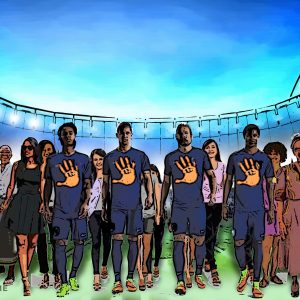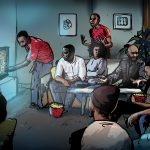Has the 2010 football sponsorship bubble burst?
The Covid-19 pandemic has devastated sport and the economies built around it. The effects will be felt for years to come, so what will South African football look like after this?
Author:
1 June 2020

In South African professional football, Covid-19 is a porcupine to the financial balloon that emerged as a result of the country hosting the 2010 Fifa World Cup.
A prickly pear, a razor blade, choose your sharp object because where financial backing, sponsorship and broadcast rights in South African sport are concerned, it’s going to be a knife fight out there. Alarmist predictions of financial meltdown, however, are also not necessarily accurate.
SuperSport United chief executive Stan Matthews says there will be no reordering of the hierarchy. The Big Three – Kaizer Chiefs, Orlando Pirates and Mamelodi Sundowns – will dominate and perhaps come out a bit stronger. That trend continues down the order through the Premier Division’s 13 other Absa Premiership and 16 GladAfrica Championship professional clubs. There will just be a smaller financial piece of the pie for which to compete.
The same applies to sport in general. The so-called big three – football, rugby and cricket – claim the lion’s share of sponsorship and broadcast rights revenue. But a trend of downsizing that had already started in football owing to South African economic pressures – budget-slashing and retrenchments by the Bidvest Wits owners being a prime example – could be exacerbated by the global and South African devastation being wrought by Covid-19. In the medium term, the financial bubble that the World Cup brought to South African football seems sure to deflate when contracts are renegotiated.
David Sidenberg, the founder of sports analysis and consultation firm Sponsor Value Research Services, has brokered some of the biggest financial partnerships in South African football. He does not foresee the near-term financial catastrophe to the Premier Soccer League (PSL) that some club owners are predicting. But as closed-door matches appear increasingly possible, following international safety models, Sidenberg does foresee greater pressure on television rights as a revenue stream, in particular on MultiChoice’s sports channel network SuperSport.
Related article:
“Before Covid-19, we were measuring the impact of the lack of SABC coverage. The SABC used to have maybe 100 PSL games a year. It’s at best half of that now,” he says.
“So before Covid-19 we had a scenario where sponsors were already under pressure to find a media return to the widest possible audience. You’ve got four or five million watching Kaizer Chiefs against Orlando Pirates on SABC. You can’t get those numbers on SuperSport.
“The thing I caution on in our industry is, yes, look at what’s going on globally but don’t get too wrapped up with it. Put it in a South African context. Sport at the highest level usually has four main sources of income – TV broadcast rights, sponsorship, licensing and merchandise, and ticketing and hospitality,” Sidenberg says.
SA’s disadvantage could be an advantage
“In some ways our greatest disadvantage is that we really only have two [broadcast and sponsorship] driving 85% to 90% of our revenue,” says Sidenberg. “We don’t fill stadiums and even when we do, tickets are a couple of hundred rand [R40 for the cheapest football ticket], not 30 000 people at £300 a pop. So when we get back and play in closed stadiums, the financial impacts are negligible. So that now becomes a huge advantage. The disadvantage is that puts that much more dependency on broadcasting sponsorship, which in many regards is already at the peak and overstated. If one blinks, the house of cards can fall really quickly.
“SuperSport, because of financial reasons – cancelled subscriptions, pressures of the economy, Netflix, the rand has been hammered – are clearly going to have their own pressures, like every broadcaster out there. Globally, Canal+ and BeIN Sports were the first to say they were not paying [France’s] Ligue 1. In the UK, Sky Sports said, ‘Subscriber, you can freeze your subscription.’
“The problem for SuperSport is if they stop taking our money then they’re going to have to start buying less content, and so which one is more important and which one breaks? If they stop paying for rights, that too becomes a breach, force majeure legal situation. So how do you secure those rights long-term? The PSL could be forced to say, ‘Well, does anyone else want to buy them?’
“Our industry has done far better in the world so far in terms of sponsors sticking by for the most part. But one thing we’ve been warning everyone to do is sit down as partners together, before it gets to the courts, before it gets to not paying. So the financial implications… we don’t know yet is the truth. Right now, we’re holding our own. But the pressure is mounting.”
Sport, broadcaster’s cash cow
While MultiChoice was facing economic pressure before the Covid-19 pandemic, it also should be aware that sport is its cash cow. South African football in particular has sold a lot of its decoders to a huge and previously untapped lower-income market. This brings into focus, too, the Independent Communications Authority of South Africa’s (Icasa) proposed broadcast rights regulations that aim to ensure games of “international interest” are shown on free-to-air television.
“Is Icasa still going to try to force SuperSport to hand over rights to SABC, which they cannot afford to pay for, at a time when we just really cannot afford to?” asks Sidenberg. “One thing you can’t knock SuperSport for is that they have been a major party to growing all of the major sports. It’s billions of rands a year that SuperSport have invested and we don’t have an SABC that can come close to that.”
Related article:
Understandably, club administrators have a higher level of anxiety while their matches remain suspended and the government, South African Football Association (Safa) and PSL seek solutions as to when a safe return can be made.
“If this thing drags on until the end of the year, the consequences are going to be severe,” says Matthews, chief executive of the channel network-owned SuperSport United club. He adds though that even with such a prognosis, clubs will adapt.
“The impact on the industry, it’s the same in any free-market system. The strong are in a position to ride through storms. People with more money can go two, three months without a salary. People with less cannot go through one month. In football, clubs like Chiefs, Sundowns and Pirates will have more clout to ride through this storm, definitely hurt like everybody, but relatively stronger than the rest of the 29 clubs. And so on down.
“When the financial pinch comes, if you have to sell a player to preserve your club, that’s what you have to do. And I anticipate that a lot of clubs are going to have to be selling players in the next transfer window. The question is, who can buy them?
“And right now, there are 29 clubs who aren’t putting up their hands to buy players. We’ll see where all the sexy signings go. And history will show that they will gravitate to the Big Three. But in a relative comparison theory, that filters down at each level. If I have to sell a player, so do clubs below me. From our perspective, nothing’s really going to change in terms of where we’ve been in the PSL for the last 20 years, just outside the top three, having a go at cups.”
Related article:
By the laws of supply and demand, it then follows that while clubs will reorganise and survive, downsizing should hit player salaries and transfer fees at a pro level. If the knock-on effects are felt further down the food chain, then it is amateur clubs, owned by a spectrum of ordinary South Africans – from wealthier small business people to informal entrepreneurs, office workers, taxi owners, teachers and community networks – who might be hit hardest.
With no grants from Safa, which oversees amateur football, and thousands of lower league team owners challenged financially to varying degrees, the coronavirus impact is unquantifiable at that level without a major study.
Proud Shoko is president of the Mogale City Local Football Association (LFA), the fifth tier of South African football at a municipal level. Employed in administration for a construction company, he owns a fourth-tier SAB League team, Golden Drifters.
The SAB leagues compete in Safa’s 52 regions.
The costs involved with running Drifters are an eye-opener. Match fees are R350, coming to R15 000 annually; league affiliation is R6 000; compulsory medicals (R350 for each of the 22 players, depending on the doctor) of around R8 000 a year; travel per match can cost R800 to R3 000 for a minibus taxi, depending on the distance, and another R20 000 annually.
So R50 000, barring additional medical costs, is not an unexpected annual figure. Shoko does not pay a coach, so he fills that role.
“We depend on fundraising and our own pockets,” Shoko says, adding that he does the rounds of players and younger players’ parents to contribute a few hundred rand each month when they can, and some local small businesses chip in, too. “Most SAB owners have small businesses, which are not even really on that [Covid-19] relief fund package that the president offered.”
At LFA level, clubs in middle-class areas charge subscriptions of R2 000 to R4 000 per player – mostly juniors – and can afford good facilities and to pay coaches. With the season facing cancellation, do parents expect their money back? Do grounds still expect to receive rent?
Shoko estimates that costs for township LFA clubs, many of which don’t charge membership fees and have limited facilities, can be as low as R10 000 annually because of near-proximity travel. “It is the clubs in the SAB and ABC Motsepe League [third tier] who will struggle most,” he says.
The economic effects of the coronavirus pandemic will permeate every level of South African football. The scale of the biggest sport in the country, which has participation in the millions, and its huge mass appeal will see it survive.
And where there are catastrophes, often there are positive spin-offs. If the bubble deflating at a professional level means less reliance by clubs on older, established players – as has become a luxury norm – and a shift to developing and fielding young talent, that could rejuvenate development-starved football in the country.



